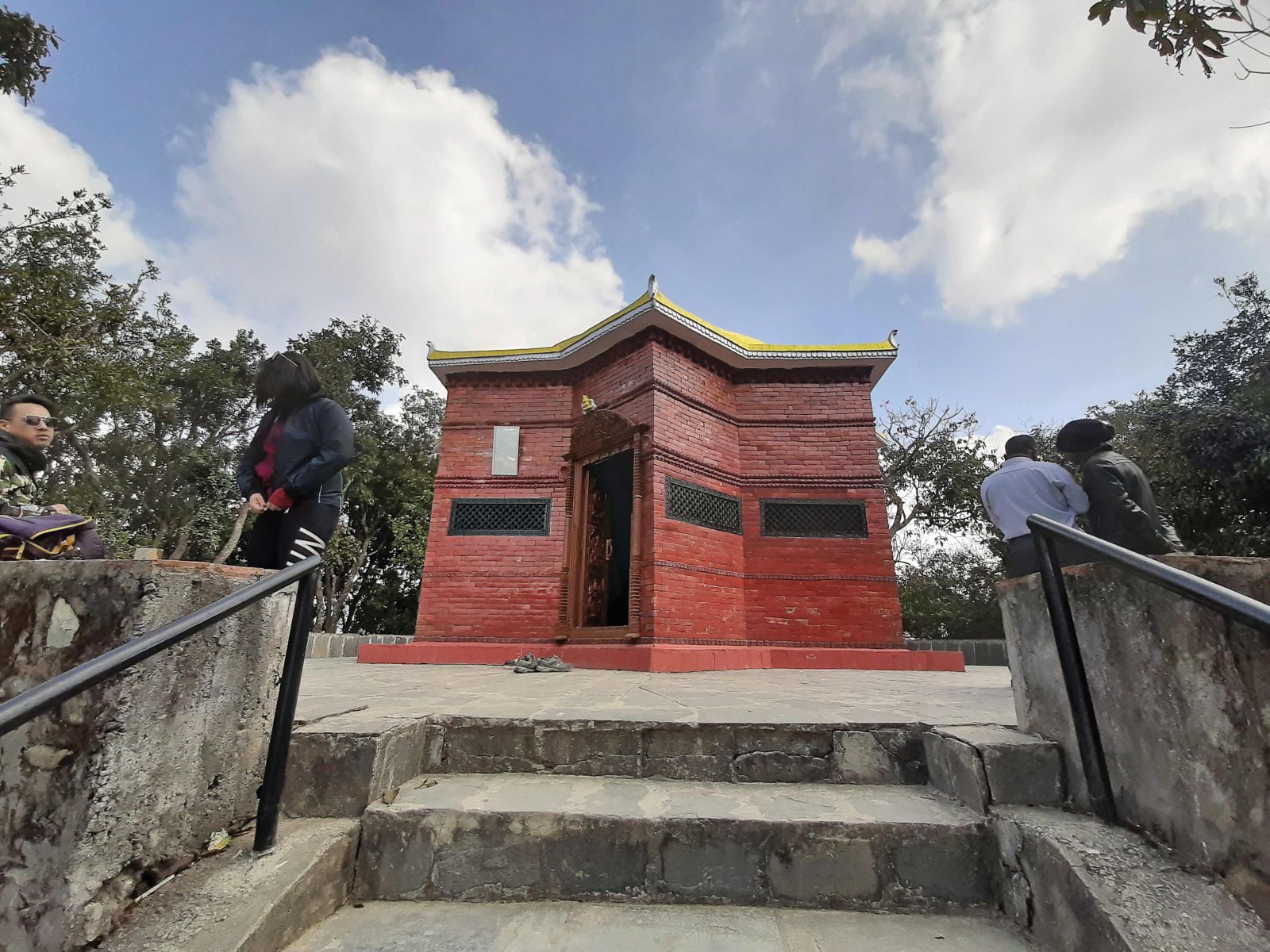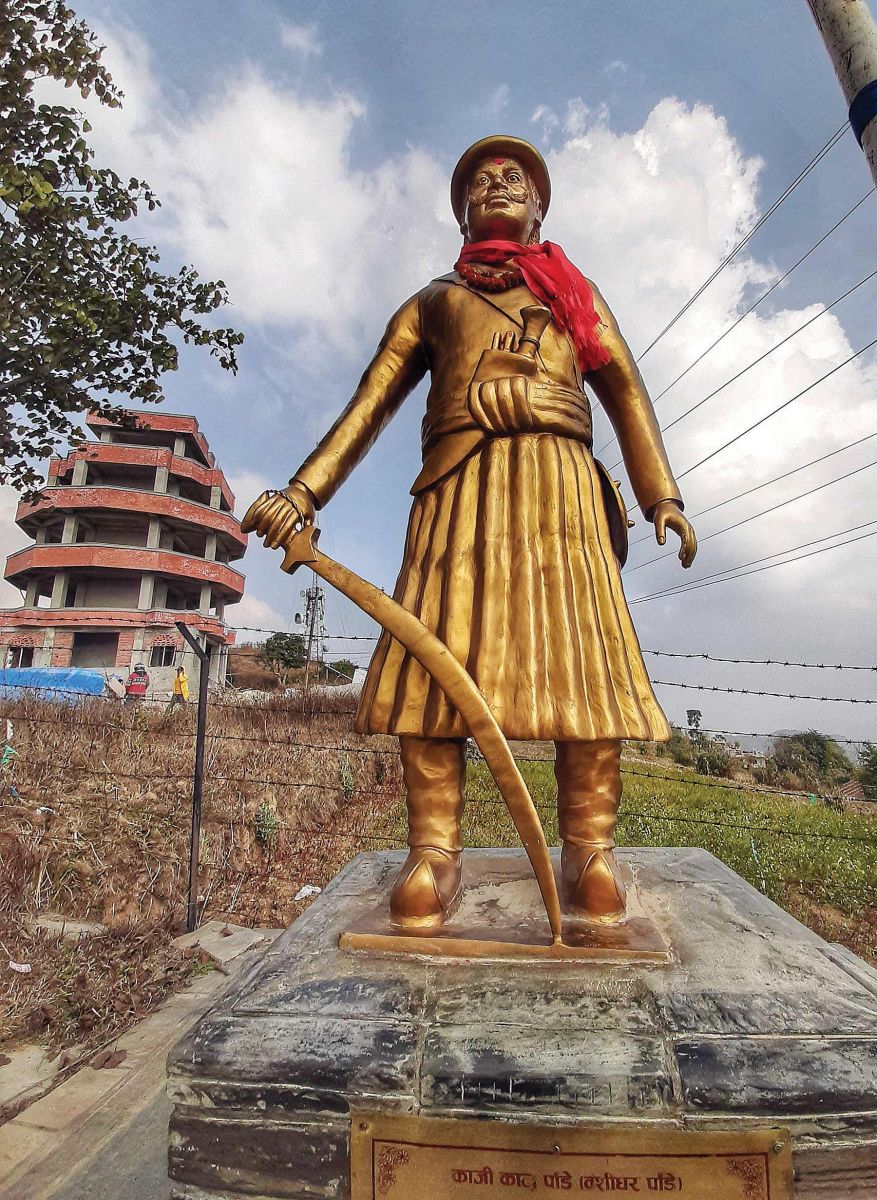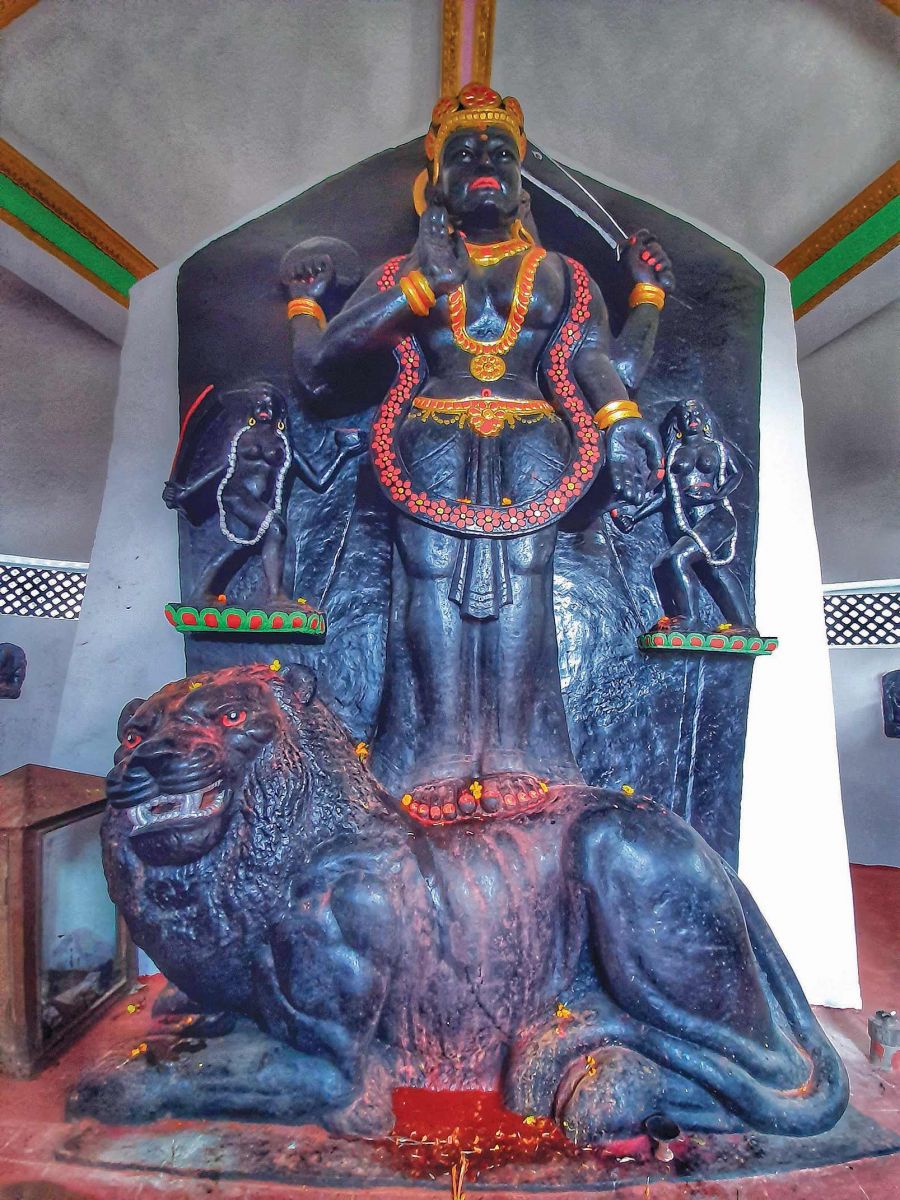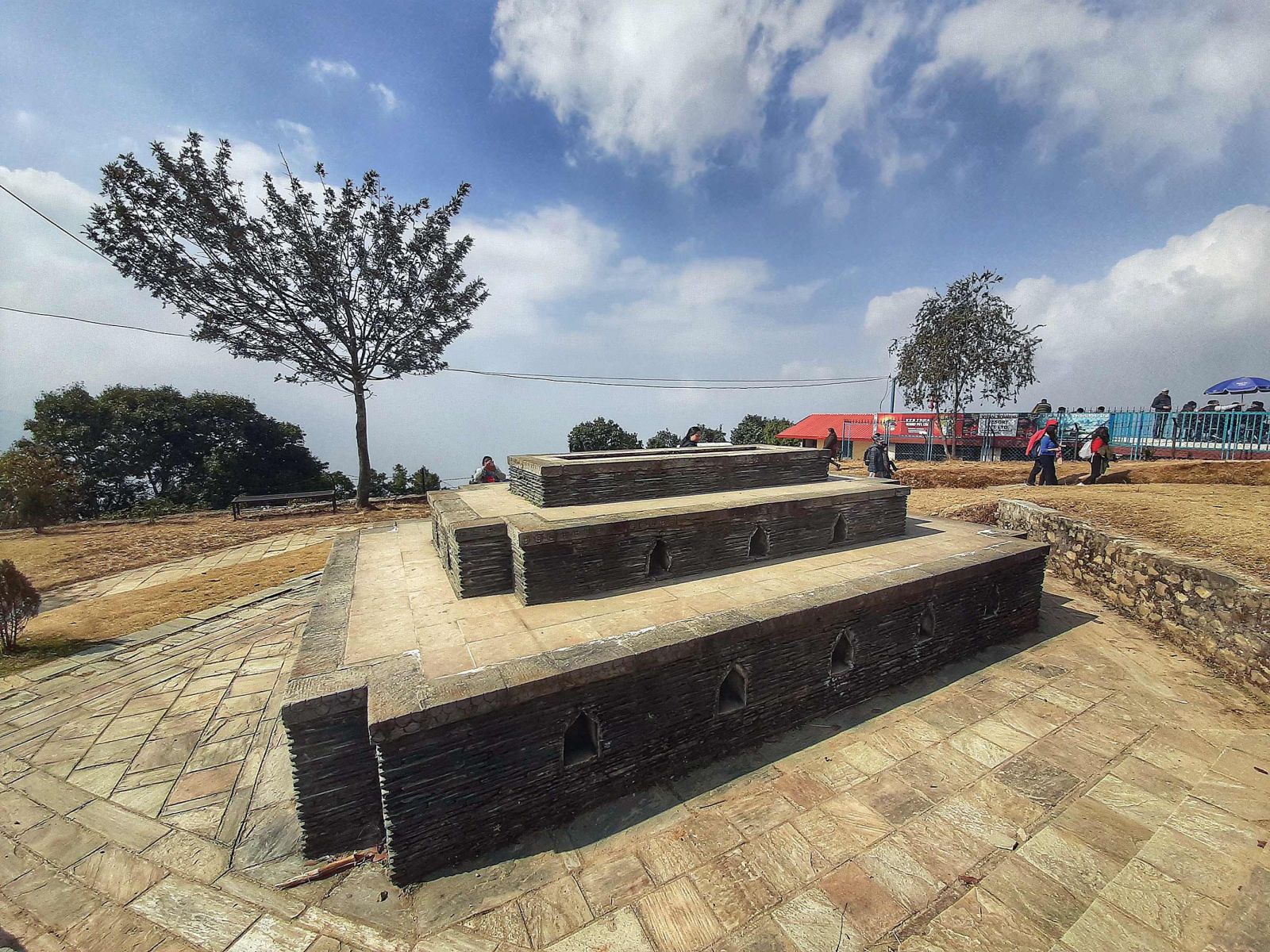
After hiking for hours, we finally reached the park. The first thing we saw was the tomb of Kaji Kalu Pande. It is believed that he wanted his final resting place to be a place from where Gorkha was visible. From the memorial complex, we can see an impressive view of Kathmandu city and the districts of Dhadhing, Nuwakot and Gorkha on a clear day.
We planned to begin the hike early in the morning to beat the heat. I reached the Ratna Park Bus park at half past eight in the morning; the most popular site for intercity buses to pick up and drop off hundreds of passengers. For those who have spent most of their lives in Kathmandu, this isn't just any bus park, it is a place that can take you into another world before your bus leaves the station. I was waiting for my friends to arrive and looking for the bus at the same time. The bus park isn't well organized and the melee of people might give you a sense of chaos, but the people running the tiny tea stalls and selling fast food give succor to passengers looking for the right bus. My friends finally arrived and we got on a bus going to Dahachowk. We chose to start our journey from Ratna Park, but there are many other routes, including from Sitapaila and Nagdhunga.
I am personally fascinated by bus journeys: they are an exhilarating escapade to distant lands. The ride started becoming bumpy after the bus headed towards Nikap from Kalanki. Although the bus goes all the way to Khahare Chowk in Dahachowk, one of the lady passengers suggested that we get off at Nikap football ground and begin our hike from there. A brisk uphill hike from Khahare Chowk will get you to the park in a rush, huffing and puffing, but we followed her suggestion and took a more gradual approach, beginning our hike from the football ground. Following the motorway, we hiked along through beautiful villages surrounded by hills. There are small shops along the way and a resort close to the park but it is better if you buy some snacks beforehand with a bottle of water.


After a while, the motorway gave way to a dirt road and the trail began to rise slightly. The road zigzags its way up the hills for about 1.5 hours until you arrive at a monastery. You will see multiple monasteries along the way. The one we tried to enter was forbidden as apparently the monks had gone on a trip! We lost our way a little bit until we met a man carrying a doko. He was selling peanuts and was heading towards the popular picnic spot called Switzerland Park. He suggested we take the road heading to the Bindabasini Temple. We bought some peanuts and followed his directions, and soon saw a flight of stairs going all the way to the temple, dedicated to Durga, the goddess of war, and you will see her giant statue with four hands standing on a fierce lion.
Down the stairs on the other side of the temple we reached Switzerland Park, which seems to have got its name from the good views of the mountains that can be seen on a clear day, though it is often murky. One of the most annoying elements of picnic spots in the capital is the noise pollution caused by music being played too loudly, but we walked further, the sound of music gave way to the sound of the wind as we saw prayer flags in the distance. It was the Indradaha (pond) named after the god of rain, the king of heaven. It is believed that long ago Indra and his mother plunged into the pond and descended to heaven on the day of the Indra Jatra festival. However, due to a lack of preservation of this site, the pond was without water; we also noticed that many temples nearby seem to have been affected by the earthquake.
Even though Dahachowk is one of those lesser-known tourist destinations, it has huge potential, and I found it fascinating that it was an important part of the Visit Nepal 1998 campaign and a Dahachwok festival was held in the area, as recorded on the stone inscription there. We rested on the grass banks and gathered some breath before heading towards the Manakamana Temple. The name Manakamana originates from two words, mana ( heart) and kamana (wish). The original Manakamana temple lies 12 km south of the town of Gorkha but this particular temple was built by Gorkha soldiers after they successfully conquered the area.
After hiking for hours we finally reached the park that was our destination. The first thing we saw was the tomb of Kaji Kalu Pande, where he was buried. It is believed that he wanted his final resting place to be a place from where Gorkha was visible. From the memorial complex, we can see an impressive view of Kathmandu city and the districts of Dhadhing, Nuwakot and Gorkha on a clear day. The intimidating sculpture of Kalu Pande beside the burial site was characterized by a big mustache and fiery eyes. The figure, holding a large sword, stands tall in the long dress of a warrior tightened round the waist with a belt, a khukuri tucked into it. The statue reveals much about how the warrior is viewed in history.

Born in 1713 AD in Gorkha, Banshidhar Kalu Pande was an important part of the Gorkhali administration by the age of 20; later he became a renowned field commander, receiving the title of Kaji, a title given to Nepali nobility during the Shah rule. He was a charismatic orator who is said to have helped in mediation between King Prithvi Narayan Shah and the King of Lamjung. By the mid 1700s he had become the right hand and trusted advisor of King Prithvi Narayan Shah.
King Prithvi Narayan Shah was a pivotal figure in the history of Nepal. Prior to his consolidation of power, most of Nepal was divided into small states. Shah succeeded in conquering and subjugating most of the states by the end of his reign. Pande had a powerful and abiding impact on the unification process of Nepal and was instrumental in the strategic attack and win over Nuwakot. One more significant step in the campaign was to conquer the southern fortress of Kathmandu Valley, Kirtipur, Although Pande had warned Shah that they were underprepared to take on the powerful city, Shah disagreed with him and waged a bitterly destructive war against the kingdom of Kirtipur, during which Kalu Pande was killed in 1757. He may be a forgotten warrior and a controversial figure, especially in Kirtipur for his role in the war, but the history of Kaji Kalu Pandey helps you understand not only the history of Nepal, but its political landscape, culture, and geography.
After enjoying the beauty and history of the park for a while, we enjoyed a flavorsome lunch and refreshing drinks in the nearby resort, the only available in the area. Heading down, we gradually descended for about an hour mostly on stone stairs covered in bushes and wild plants, until we arrived at the Khahare bus stop. You might have to walk on slippery stones on your way down, particularly in the monsoon season so prepare accordingly. However you can also go clockwise on a loop trail along a dirt road which might take you a bit longer. At the end of our hike, we stopped in a tea shop run by a wonderful family. The tea was fantastic and everyone was friendly, especially the proprietor's son who added some much needed laughter at the end of our strenuous hike. We finally caught the last bus, our ticket to return to a familiar setting.

Massage Away your Stress
A Five Thousand-Year-old Ayurvedic massage helps you de-stress from your hectic life. Life brings in a lot...








